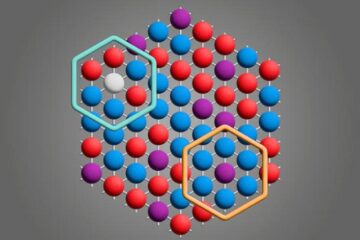New antenna tech to equip ceramic coatings with heat radiation control

Researchers have engineered ceramic nanotubes, which act as antennas that use light-matter oscillations to control heat radiation. The design is a step toward a new class of ceramics that work more efficiently at high temperatures. Credit Purdue University illustration/Xueji Wang
Researchers at Purdue University have engineered ceramic “nanotubes” that behave as thermal antennas, offering control over the spectrum and direction of high-temperature heat radiation.
The work is published in Nano Letters, a journal by the American Chemical Society. An illustration of the ceramic nanotubes will be featured as the journal's supplementary cover in a forthcoming issue.
“By controlling radiation at these high temperatures, we can increase the lifetime of the coating. The performance of the engine would also increase because it could be kept hotter with more isolation for longer periods of time,” said Zubin Jacob, an associate professor of electrical and computer engineering at Purdue.
The work is part of a larger search in the field for a wide range of materials that can withstand higher temperatures. In 2016, Jacob's team developed a thermal “metamaterial” – made of tungsten and hafnium oxide – that controls heat radiation with the intention of improving how waste heat is harvested from power plants and factories.
A new class of ceramics would expand on ways to more efficiently use heat radiation.
Jacob's team, in collaboration with Purdue professors Luna Lu and Tongcang Li, built nanotubes out of an emerging ceramic material called boron nitride, known for its high thermal stability.
These boron nitride nanotubes control radiation through oscillations of light and matter, called polaritons, inside the ceramic material. High temperatures excite the polaritons, which the nanotubes – as antennas – then couple efficiently to outgoing heat radiation.
The antennas could bring the ability to accelerate the radiation, perform enhanced cooling of a system or send information in very specific directions or wavelengths, Jacob said.
The researchers plan to engineer more ceramic materials with polaritonic features for a host of different applications.
“Polaritonic ceramics can be game changing and we want them to be used widely,” Jacob said.
This research was performed in the Purdue Discovery Park Birck Nanotechnology Center and is supported through Nascent Light-Matter Interactions, a program by the Defense Advanced Research Projects Agency. The program is led by Purdue University's School of Electrical and Computer Engineering.
###
About Discovery Park
Discovery Park is a place where Purdue researchers move beyond traditional boundaries, collaborating across disciplines and with policymakers and business leaders to create solutions for a better world. Grand challenges of global health, global conflict and security, and those that lie at the nexus of sustainable energy, world food supply, water and the environment are the focus of researchers in Discovery Park. The translation of discovery to impact is integrated into the fabric of Discovery Park through entrepreneurship programs and partnerships.
ABSTRACT
High-Temperature Polaritons in Ceramic Nanotube Antennas
Ryan Starko-Bowes,1 Xueji Wang,2 Zhujing Xu,2 Sandipan Pramanik,1 Na Lu,2 Tongcang Li,2 and Zubin Jacob1,2
1 University of Alberta, Edmonton, Alberta, Canada
2 Purdue University, West Lafayette, Indiana, USA
DOI: 10.1021/acs.nanolett.9b03059
High-temperature thermal photonics presents unique challenges for engineers as the database of materials that can withstand extreme environments are limited. In particular, ceramics with high temperature stability that can support coupled light-matter excitations, that is, polaritons, open new avenues for engineering radiative heat transfer. Hexagonal boron nitride (hBN) is an emerging ceramic 2D material that possesses low-loss polaritons in two spectrally distinct mid-infrared frequency bands. The hyperbolic nature of these frequency bands leads to a large local density of states (LDOS). In 2D form, these polaritonic states are dark modes, bound to the material. In cylindrical form, boron nitride nanotubes (BNNTs) create subwavelength particles capable of coupling these dark modes to radiative ones. In this study, we leverage the high-frequency optical phonons present in BNNTs to create strong mid-IR thermal antenna emitters at high temperatures (938 K). Through direct measurement of thermal emission of a disordered system of BNNTs, we confirm their radiative polaritonic modes and show that the antenna behavior can be observed even in a disordered system. These are among the highest-frequency optical phonon polaritons that exist and could be used as high-temperature mid-IR thermal nanoantenna sources.
Media Contact
All latest news from the category: Materials Sciences
Materials management deals with the research, development, manufacturing and processing of raw and industrial materials. Key aspects here are biological and medical issues, which play an increasingly important role in this field.
innovations-report offers in-depth articles related to the development and application of materials and the structure and properties of new materials.
Newest articles

Microscopic basis of a new form of quantum magnetism
Not all magnets are the same. When we think of magnetism, we often think of magnets that stick to a refrigerator’s door. For these types of magnets, the electronic interactions…

An epigenome editing toolkit to dissect the mechanisms of gene regulation
A study from the Hackett group at EMBL Rome led to the development of a powerful epigenetic editing technology, which unlocks the ability to precisely program chromatin modifications. Understanding how…

NASA selects UF mission to better track the Earth’s water and ice
NASA has selected a team of University of Florida aerospace engineers to pursue a groundbreaking $12 million mission aimed at improving the way we track changes in Earth’s structures, such…





















